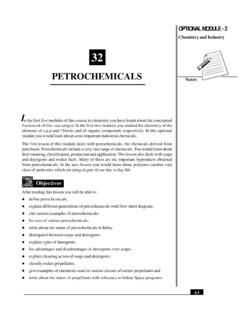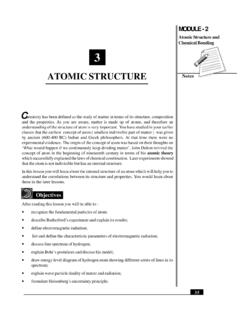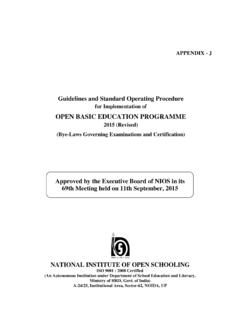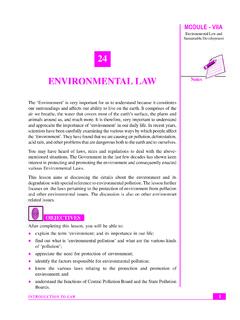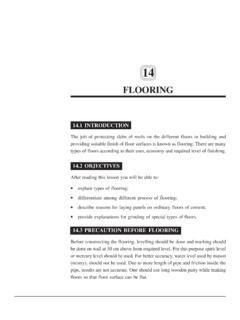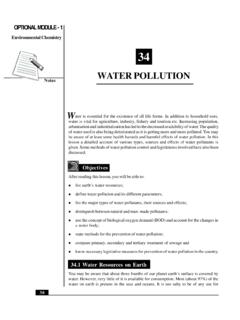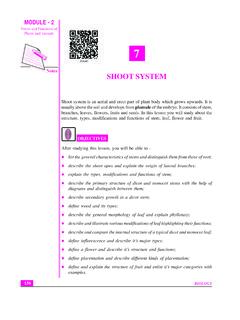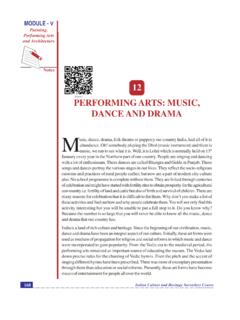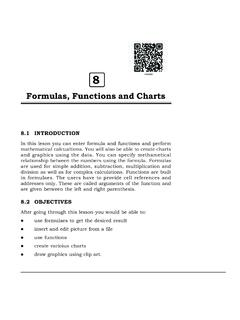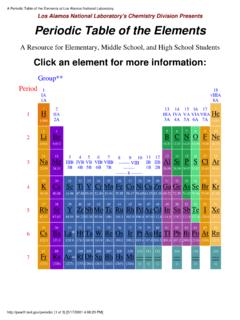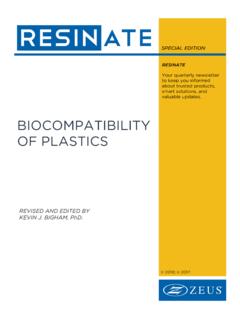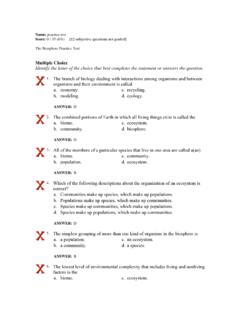Transcription of Notes NUTRITION IN PLANTS MINERAL NUTRITION
1 NUTRITION in PLANTS MINERAL NUTRITION 217 BIOLOGYN otesMODULE - 2 Forms and Functions ofPlants and animalsSometimes you may observe that a potted plant kept in sunlight and provided withsufficient water does not grow. Its leaves look pale and weak. Plant may not evenflower properly. Such a situation is an indication, that the plant may not be gettingall that is required for normal growth and most of such situations one or more minerals required may be lacking in the might have seen farmers adding some extra manure (khad) to the soil. In thislesson you will learn the importance of MINERAL NUTRITION in completing this lesson, you will be able to :zdefine the terms MINERAL NUTRITION , macro and micro nutrients;zexplain the functions of minerals with reference to the techniques of hydroponicsand aeroponics;zlist the role of macro and micro nutrients;zmention the deficiency symptoms of macro and micro nutrients;zdifferentiate between autotrophic and heterotrophic NUTRITION in plant;zdescribe the saprophytic and parasitic modes of NUTRITION in WHAT IS PLANT NUTRITIONAs you know that all living organisms require food to survive, grow and reproduceso every organism takes in food and utilizes the food constituents for itsrequirements of growth.
2 A series of processes are involved in the synthesis of foodby PLANTS , breaking down the food into simpler substances and utilization of thesesimpler substances for life processes. NUTRITION in PLANTS may thus be defined asa process of synthesis of food, its breakdown and utilisation for various functionsin the IN PLANTS MINERALNUTRITIONN utrition in PLANTS MINERAL NutritionBIOLOGY 218 NotesMODULE - 2 Forms and Functions ofPlants and animalsThe chemical substances in food are called nutrients CO2, water, minerals,carbohydrate, protein, fats etc. Green PLANTS can make their own organic food fromsimple substances like water and carbon dioxide through the process of photosynthesisand are called autotrophs (auto : self; trophos : feeding). But the non-green plantsand other organisms which cannot prepare their own food and obtain NUTRITION fromgreen PLANTS are called heterotrophs (heteros : different). MINERAL NUTRITIONNow we will discuss how PLANTS get the nutrients.
3 You already know thatcarbohydrates are synthesised by the process of photosynthesis. What are theelements present in these carbohydrates?Carbon, hydrogen and oxygen are the main elements in carbohydrates, fats andproteins. In addition to these three elements, PLANTS need a variety of elements fortheir survival. These are generally referred to as MINERAL elements. They are absorbedby the root system of PLANTS in the form of their study of how PLANTS get MINERAL elements and utilize them for their growth anddevelopment is called MINERAL the minerals are not available to PLANTS , specific symptoms appear due to thedeficiency of a particular element. There are methods to determine the requirementof minerals by PLANTS . Some such methods are given METHODS TO DETERMINE THE REQUIREMENT OF MINERALSFOR PLANTM inerals are absorbed by PLANTS in solution form. So it is possible to grow plantsin water containing the desired amount of MINERAL salts taking care that the aerialparts are exposed to air and technique of growing PLANTS in a nutrient solution in complete absenceof soil is known as Hydroponics/water was demonstrated for the first time by a German Botanist Julius Von Sachsin the year water culture experiments, seedlings are made to grow in water containing theknown nutrients in a particular proportion.
4 Vigorous bubbling of the air is routinelydone to provide sufficient oxygen to the root system. The culture solutions maycontain all essential nutrients except the one whose importance is to be the plant growing in it is compared to the one growing with all essentialnutrients (control experiment). NUTRITION in PLANTS MINERAL NUTRITION 219 BIOLOGYN otesMODULE - 2 Forms and Functions ofPlants and animalsFig. Experimental set up for nutrient solution culture of culture experiments help us to understand :(i) which element is essential for normal growth of the plant.(ii)which element is not essential and is absorbed along with other nutrients.(iii)how much quantity of each MINERAL is has been successfully employed for the commercial production ofseedless cucumber, tomato and : Like hydroponics, aeroponics is another technique of growingplants in an air/mist environment without the use of is a technique of growing PLANTS with their roots supplied with moisturepresent in the air.
5 Rooted PLANTS are placed in a special type of box. The shootsof the rooted PLANTS are exposed to air and the roots are inside the box havingcomputer controlled humid atmosphere. The roots are sprayed/misted for shortdurations with a hydro-atomized pure water/nutrient solution. This method has beendeveloped recently. Since PLANTS cultured by this technique get a very good growthof root hairs, it is very useful method for research purposes. Citrus PLANTS and oliveshave been successfully grown through QUESTIONS What are nutrients ?..2. Define Why is it necessary to aerate nutrient solution in water culture?..Aerating tubeNutrient solutionFunnel foradding waterand nutrientsNutrition in PLANTS MINERAL NutritionBIOLOGY 220 NotesMODULE - 2 Forms and Functions ofPlants and ESSENTIAL MINERAL ELEMENTSYou know that 112 elements have been discovered until now. So you might bewondering whether PLANTS require all 112 elements for their MINERAL NUTRITION .
6 Mostof the MINERAL elements present in soil are absorbed by roots of the plant. But allare not essential. Only 17 elements are considered as essential for the PLANTS . Letus now discuss the criteria for the essentiality of an element for normal plant Criteria for Essentiality of ElementsThe nutrients or elements which are essential for the healthy growth of the plantare called essential nutrients or essential elements. The roots absorb about 60elements from the soil. To determine which one is an essential element, the followingcriteria are used :(i) An essential element is absolutely necessary for normal growth andreproduction of the plant, and should be a part of essential metabolite for plantgrowth.(ii)The requirement of the element is very specific and it cannot be replaced byanother element.(iii)The element is directly or indirectly involved in the metabolism of a plant.(iv) In the deficiency of an essential element, the plant would exhibit specificsymptoms of deficiency, and the plant would recover from its symptoms, ifsupplied with the deficient : Magnesium is said to be an essential element because it is essential forthe formation of chlorophyll molecule.
7 Its deficiency causes yellowing of Types of Essential ElementsEssential elements may be required in small amounts or large amounts. Accordinglythey have been grouped into two categoriesEssential ElementsMicro elements/MicronutrientsMacro elements/Macro nutrientsRequired in minute quantitiesRequired in relatively large quantitieslike mg per gram of drylike one to 10 milligram per gram ofmatter or less than that. Also calleddry matteras trace : Manganese, Boron, cobattExamples : Carbon, Hydrogen, OxygenCopper, Molybdenum, Iron, ZincPhosphorous, Potassium, Calcium andand Chlorine are required in verymagnesium, Nitrogen, Sulphursmall Sources of Essential Elements for PlantsAfter studying the types of essential elements we will now discuss about theirsources. Most of the essential elements are taken from soil, and some from theatmosphere. The table given below focuses on the sources of different in PLANTS MINERAL NUTRITION 221 BIOLOGYN otesMODULE - 2 Forms and Functions ofPlants and animalsTable Sources of Essential ElementsElementsSources of the elementsCarbonTaken as CO2 from the atmosphere (air)OxygenAbsorbed in the molecular form from air or fromwater.
8 It is also generated within a green plant from water during photosynthesis in thegreen plantNitrogenAbsorbed by the PLANTS as nitrate ion(NO3 ) or as ammonium ion (NH4+) from the organisms like bacteria and cynobacteria canfix nitrogen from air , calciumabsorbed from the soil (are actually derivediron, phosphorus, sulphurfrom the weathering of rocks. So they aremagnesiumcalled MINERAL elements). They are absorbed in theionic forms K+, Ca2+, Fe3+, H2PO4 / HPO42 QUESTIONS In which form do PLANTS get oxygen?..2. Molybdenum is a micronutrient. Give Why are carbon, oxygen, potassium and sulphur called macronutrients?.. ROLE OF MACRO AND MICRO NUTRIENTSE ssential elements perform various functions. They carry out several metabolicprocesses in the plant cells like the maintenance of turgidity of cell, transportationof electrons, membrane permeability and enzyme activity.
9 Essential elements alsoact as important constituents of the biomolecules and co-enzymes. Various functionsof the macro and micro nutrients are given in the following forms in which the elements are taken in and their functions are described inthe table given below - NUTRITION in PLANTS MINERAL NutritionBIOLOGY 222 NotesMODULE - 2 Forms and Functions ofPlants and animalsTable Essential Elements and their FunctionsElementForm in whichRegion of the plantFunctionthe element isthat requires thetaken inelementNitrogen, NNO2 , NO3 All tissues, particularlyRequired for the synthesisor NH4+ ionsin meristematic tissuesof amino acids, proteinsnucleic acids, vitamins,hormones, coenzymes,ATP and , PH2PO4 orYoung tissues fromRequired for the synthesisHPO42 the older metabolicallyof nucleic acids phospho-less active cellslipids, ATP, NAD andNADP. Constituent of cellmembrane and some , KK+Meristematic tissuesActivates enzymes,buds, leaves and rootassociated with K+/Na+ in active transport,anion-cation balance in thecells.
10 Brings about openingand closing of in cell sap in plantcell vacuole and helps inturgidity of , CaCa2+Meristematic andPresent as calcium pectatedifferentiating tissuesin the middle lamella ofAccumulates in oldercell walls that joins theleavesadjacent cells enzymes neededfor the growth of root andshoot tip. Needed fornormal cell walldevelopment. Required forcell division, ,Mg2+Leaves of the plantForms part of theMgchlorophyll enzymes ofphosphate for synthesis ofDNA and RNA. Essential forbinding of ribosome , SSO42 Stem and root tipsAs a constituent of aminoyoung leaves of theacids cysteine andplantmethionine and of someproteins. Present inco-enzyme A, vitaminthiamine, biotin andferredoxin. Increases rootdevelopment. Increases thenodule formation in PLANTS MINERAL NUTRITION 223 BIOLOGYN otesMODULE - 2 Forms and Functions ofPlants and animalsIron, FeFe3+Leaves and seedsNeeded for the synthesis ofchlorophyll.
